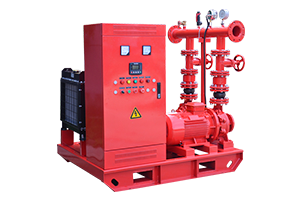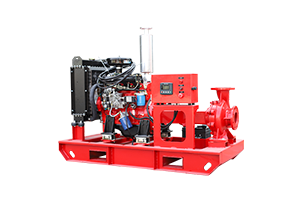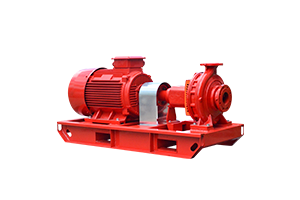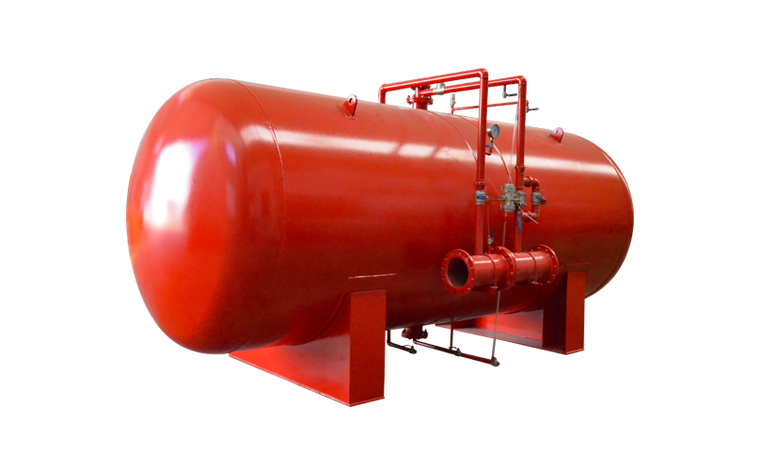-
 Dec 30, 2022Layout requirements and installation methods of fire water supply pipes and causes of water leakageLayout requirements and installation methods of fire water supply pipes and causes of water leakage
Dec 30, 2022Layout requirements and installation methods of fire water supply pipes and causes of water leakageLayout requirements and installation methods of fire water supply pipes and causes of water leakage
1. Requirements for outdoor fire pipeline layout
(1) When two-way fire water supply is used for outdoor fire water supply, ring pipe network should be used, but when one fire water supply is used, branch pipe network can be used.
(2) There are no less than 2 water inlet pipes delivering water to the ring pipe network, each of which can pass through the entire flow.
(3) Valves should be used to divide the circuit into separate parts. The number of outdoor fire hydrants in each section shall not exceed 5
(4) The diameter of the outdoor fire water supply pipe should not be less than DN100. When conditions permit, it should not be less than 150mm.
Pressure reducing valve setting
(1) A pressure relief valve should be installed before the inlet of the alarm valve. When connecting two or more alarm valves, a backup pressure reducing valve should be installed.
(2) A filter should be installed at the inlet of the pressure reducing valve, and the flow area should not be less than 4 times the cross-sectional area of the pipeline;
(3) The pressure gauge should be installed before and after the filter and pressure reducing valve. The diameter of the pressure gauge should not be less than 100mm, and the range should be twice the design pressure;
(4) The control valve should be installed before the filter and after the safety valve.
(5) After the pressure relief valve, a pressure test drain valve should be installed;
(6) The pressure reducing valve shall be equipped with a flow detection test interface or a flow meter;
(7) Pressure relief valves installed vertically shall flow downward.
(8) The proportional pressure reducing valve should be installed vertically, and the adjustable pressure reducing valve should be installed horizontally.
Indoor fire water supply pipeline
1. The following fire water supply pipe networks are circular:
(1) Supplying water to two or more buildings;
(2) Water is supplied to more than two water fire extinguishing systems;
(3) When using a temporary high-pressure fire water supply system with a high fire water tank;
(4) When supplying water to an automatic water fire extinguishing system controlled by two or more alarm valves.
A fire pump is a machine used to transport fire water. However, because some failures are prone to occur under different working conditions, the water leakage of the fire pump is one of them. There are both internal leakage and external leakage of fire pump water leakage, but any of them will affect the normal flow and lift of the fire pump.
First, it's easy to understand leaks. The leakage is that from the outside of the fire pump, it can be clearly seen that there is water leakage from the fire pump body. The location of the leakage is not fixed, but most of the leakage occurs on the mechanical seal, shaft seal and motor joints, even on the surface of the pump body. .
The internal leakage of the fire pump cannot be displayed, but its flow rate and lift are significantly reduced. However, whether it is internal leakage or external leakage is a fire pump failure, we need to identify it carefully and deal with it in time to prevent greater failures.
2. Causes and treatment methods of fire pump leakage
There are many reasons for fire pump leakage, including damage to the sealing surface, unevenness, loosening of bolts during installation, sand holes or cracks in the pump body, etc. Check the location of the fire pump leak to determine if there is a possibility of damage near it. For example, there is more leakage near the mechanical seal, so we can first judge the problem of the mechanical seal. If the pump body leaks, the pump body may have cracks.
After determining the cause of the leakage, the fire pump will be dismantled for further confirmation. If it's a sealing problem, you'll need to reseal and replace the gasket. When it is confirmed that there is a crack in the pump body, it should be replaced directly, and it is forbidden to continue to use it.
The reason for the internal leakage is mainly due to the damage of the check valve. In order to judge whether there is an internal crack, it is only necessary to stop the fire pump for a period of time, and then observe the pointer of the pressure gauge installed on the outlet pipe of the fire pump. You can accurately determine if the pump is leaking without changing it. If internal leakage is found, the seal of the check valve needs to be repaired or replaced with a new one.View details -
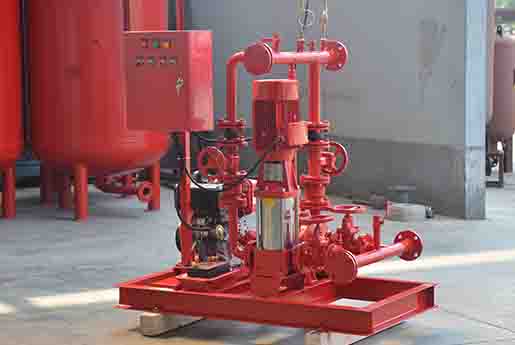 Dec 30, 2022What to do if the fire pump produces noise and what are the more common problemsWhat to do if the fire pump produces noise and what are the more common problems
Dec 30, 2022What to do if the fire pump produces noise and what are the more common problemsWhat to do if the fire pump produces noise and what are the more common problems
1. When the pipeline fire pump noise occurs, the most likely fault is the imbalance of the fire pump rotor. Since the water output of the fire pump mainly depends on the high-speed rotation of the rotor, when the rotor is unbalanced for some reason, it will cause the fire pump to deviate from the original rotation track during the rotation process, resulting in the fire pump appearing in the pipeline. When judging the failure of the rotor, it is mainly to replace the rotor of the pump or make a balance hole on the rotor blade of the pump to find out the balance difference.
2. The production noise of the fire pump pipeline has a certain effect. For example, forcing a small flow of a pipe "fire pump" to increase power to increase the original flow will create vibrations in the fire pump. Therefore, whether you use a pipeline fire pump or other types of water pumps, you should follow the water pump use standards to prevent the water pump from making noise, which will affect the service life of the water pump. The solution is to use the pump according to the instructions. If the efficiency of use is affected, it is recommended to replace the appropriate pipeline "fire pump" for use.
3. The installation did not meet the standards, resulting in abnormal noise from the pipeline fire pump. Fire pumps and fire hydrant pumps vibrate at a high frequency during operation, so they must be fixed during installation. If the bolt between the pump body and the base or between the base and the base is loose when installing the pipe fire pump, the transmission shaft between the pump body and the motor of the pipe pump will be bent. It lowered the concentricity and caused an imbalance in the fire pump rotor. This is one of the noise phenomena of fire pumps. In order to improve this phenomenon, the pump shaft of the fire pump needs to be balanced and then reinstalled. Finally, the base of the pump was reinforced.
4. Blockage of the impeller passage can also cause fire pump noise. When the internal flow channel of the fire pump is blocked by foreign matter, it will cause uneven resistance of the fire pump impeller and vibrate the fire pump. Therefore, it is necessary to regularly disassemble and maintain the fire pump to prevent foreign matter from blocking the pipeline.
5. The bearing of the fire pump is damaged. Bearing damage generally does not occur on the main body of an in-line fire pump. If there is a problem with the quality of the pump, or because some hard objects enter the pump body of the tube pump, the bearing is damaged, and the rotor is unstable at first. Causes noise from pipeline fire pumps.
6. Finally, cavitation, cavitation occurs in any type of pump, but some are obviously not noticeable. If cavitation occurs, consider raising the fire pump or increasing the pressure in the piping. If the cavitation phenomenon cannot be changed, the fire pump model needs to be redesigned and replaced.
1. Why is the fire pump also called XBD fire pump set?
Answer: In fact, the water pumps used in fire protection are not only XBD fire pump sets. Fire pumps can be divided into ordinary fire pumps XB and vehicle fire pumps CB according to their mobility. According to the characteristics of the prime mover, they also include electric motors (D), gasoline engines (Q), and diesel engines (C), so XBD can be understood as ordinary electric fire pumps .
2. Are all water pumps subject to anti-corrosion tests?
A: Before installation, fire pumps are often subjected to many tests such as performance, operation, vacuum sealing, corrosion resistance, etc. to ensure that the pump can be used normally for a sufficient period of time. When the material of the flow-passing parts is aluminum alloy, bronze, stainless steel, and the material of the pump casing is cast iron, cast copper, or cast aluminum, anti-corrosion tests are not required because of the chemical properties of the material.
3. Are the most important parameters of the fire pump the flow and lift or the flow and pressure?
Answer: First of all, we must understand the relationship between pressure and lift: pressure = liquid density * g * lift (g = 0.981). In fact, the fire water pump can not only transport water, as long as the physical and chemical characteristics and water liquid are fine, but most of them transport water in daily life. The density of water is 1 ton per cubic meter. It can be obtained from the above formula : Pressure=1000*0.981*lift, pressure=0.981*lift, at this time the pressure and lift are almost the same, so whether we refer to lift or pressure, it can basically be regarded as a parameter.View details -
 Dec 30, 2022How to maintain the fire pump correctly and choose the electrified power reasonablyHow to maintain the fire pump correctly and choose the electrified power reasonably
Dec 30, 2022How to maintain the fire pump correctly and choose the electrified power reasonablyHow to maintain the fire pump correctly and choose the electrified power reasonably
How to maintain the fire pump is the simplest and most economical repair. It is necessary to prevent damage to the fire pump that prolongs the service life and prolong the service life. Naturally, it saves us money. In order to save costs, our daily maintenance can be like this.
First of all, check whether the oil level is normal and cannot reach the oil mark line on the normal surface. If it is not, we must replenish it in time, but remember one thing, it cannot exceed the amount of the oil quantity indicator line.
Secondly, check the radiator. The water is appropriate. If it is not added in time, the water that needs to be added must be clean water, as long as it is clean water, or tap water is fine. Why not use groundwater, because impurities in groundwater can easily form scales in the water tank, which affects the cooling effect and is also prone to failure. In winter, we drive to preheat the car, add coolant to the car, and the fire pump is no exception. The weather in the north is very cold, so add the coolant to the fire pump according to the actual temperature.
Finally, check the installation of each part of the fire pump, such as whether they are stable, the connection between the screw and the screw, if there is any looseness, tighten the screw in time. To clean the fire pump, soak a canvas or dry cloth and wipe slowly on the body or on surfaces made of grease or dust.
Only when the power is in the normal range can the fire pump be used efficiently. The requirements for the use of pump equipment are relatively strict, and there may not even be a slight leak, otherwise the use of the pump will be adversely affected. I hope that you need to know before using the pump. Remember:
The energizing power should be selected reasonably.
1. Water irrigation treatment Before selecting the power-on power, make sure that the fire pump is turned off, and the water in the pump should be filled to increase the suction, so as to make the pressure difference larger and quickly clean up some acid-base reagents and other pollutants. Make sure to fill the water well.
2. Selection of electrified power The horsepower of the fire pump will be selected according to the size of the pump. Before electrifying the pump, carefully check the electrical power. Once the power is not grasped accurately, it is easy to cause insufficient suction. Therefore, in order to make it have sufficient suction, the power should be selected reasonably. If there is no electricity, the fire pump cannot be started, let alone used. But does it mean that the pump can be used as long as there is electricity? Not necessarily, the pump can only be used if the electrified power is reasonable and the voltage is within the normal range.View details -
 Dec 30, 2022What to pay attention to when choosing a fire pump certification company and how to maintain a fire hydrant pumpWhat to pay attention to when choosing a fire pump certification company and how to maintain a fire hydrant pump
Dec 30, 2022What to pay attention to when choosing a fire pump certification company and how to maintain a fire hydrant pumpWhat to pay attention to when choosing a fire pump certification company and how to maintain a fire hydrant pump
Fire pumps are pumps used in fire fighting. They are divided into different types. Because of their fully sealed, non-exposed and corrosion-resistant characteristics, they are widely used in environmental protection, water management, fire protection and other departments to pump various liquids. They are leak-free and non-toxic. The ideal pumps for polluting elegant workshops and civilized factories are similar to the pumps used for fire protection, but the head and flow are different.
1. Adjust the tightness of the packing gland at any time according to the operating conditions of the fire pump. Seasoning seal drips 30 to 60 drops per minute.
2. Pay attention to the wear of the seasoning and adjust the filler in time. When replacing the packing, every time the packing is replaced, the joints of each adjacent packing should be staggered by more than 90 degrees, the water seal pipe should be aligned with the water seal pipe, and the opening of the outermost packing should be downward.
3. The fire pump should increase the lubrication or grease in the bearing in time to ensure that the oil level is normal, and check the oil quality change on a regular basis. If the oil quality is not good, replace it with new oil.
4. Regularly check the limit switch of the electric power valve and the manual and electric interlocking equipment.
5. The vibration of the pump should be checked regularly. When the vibration is unreasonable, the cause should be found out and dealt with in time.
6. Check, adjust and replace valve packing regularly to ensure no water leakage, no oil stain and no rust.
7. When using soft packing to seal, the packing should be added at any time according to the actual situation to prevent leakage.
8. The parts and components of the fire pump should be completely intact, and the handwriting on the assigned nameplate should be clear.
9. The external parts of the equipment should be perfect: no rust, no oil leakage, no electricity leakage, no water leakage, no air leakage.
The focus of the next step for fire pump manufacturers is how to maintain and maintain them. The more you pay attention to maintaining it, the more time you spend getting the product.
The maintenance of the fire hydrant pump is too much.
First, every time it is used, the location must be checked to ensure that the power supply and circuit of the fire protection system are in normal working condition. It is important to check regularly, 5 days a month. What to check? The lubricating oil level in the pump must be checked, and the filling position must be checked to see if it is in the center of the oil window or not above the center line.
Second, be punctual when checking the water on the pump and record relevant information. After the pump is officially started, check the operation of the float ball, and there must be no water in the exhaust pipe. If so, replace the floating ball seal in time. After the pump is started, check whether the exhaust is normal, whether the vacuum device is tightly sealed, and whether the exhaust is normal.
Fire pump manufacturers believe that the importance of maintenance and maintenance of fire hydrant pumps makes the service life longerView details -
 Dec 28, 2022Introduction to the characteristics of fire pumps and how to operate them correctlyIntroduction to the characteristics of fire pumps and how to operate them correctly
Dec 28, 2022Introduction to the characteristics of fire pumps and how to operate them correctlyIntroduction to the characteristics of fire pumps and how to operate them correctly
A fire pump is a single suction section of a vertical centrifugal pump used to deliver water free of solid particles, whose physical and chemical properties are similar to water in liquid. It is mainly used for pressurized water supply in fire protection systems, and can also be used for industrial water supply and drainage. The flow rate of the conveying liquid is in the range of 5-80 L/s, the pressure range is 0.2-0.2 MPa, the power range is 1.5-200 kW, and the diameter range is φ50-φ200 mm.
Main application: The vertical fire pump is mainly used in pipeline pressurization fire protection system. It is also applicable to industrial and urban water supply and drainage, high-rise building pressurized water supply, long-distance water supply, heating cold and hot water cycle pressurization, bathroom, boiler, air conditioning and refrigeration system Water delivery and supporting equipment, etc. new vertical multi-stage fire pump, including inlet, impeller, shaft, middle, water section, guide vane, impeller is set on the guide vane and discharge through the main shaft; guide vane is set on the middle part. Outlet section flow The channel is in the shape of a volute, and the final impeller is directly installed in the volute.
The new vertical multi-stage fire pump is not installed at the end of the guide vane in the water, and the water level at the end of the impeller is directly discharged to the outlet section of the spiral flow channel, and then passes through the outlet. It can improve the flow state of the water, reduce energy loss, and increase the efficiency of the pump. Efficiency, more beneficial is that it can greatly reduce the vibration and noise of the pump. Fire pumps are mainly used in pipeline pressurization fire protection systems. They can also be used in industrial and urban water supply and drainage, high-rise building pressure water supply, long-distance water supply, heating, toilets, boilers Cold and hot water cycle pressurization, air conditioning and refrigeration system water supply and supporting equipment, etc.
The preparations that the fire pump needs to make before work first depends on whether the motor steering is correct. This can be seen on the mark on the fire pump body. The time should be short to avoid wear and tear. When using it, open the exhaust valve and wait until When the liquid occupies the entire pump body, it is closed. If it is a high-temperature type, it needs to be preheated. This is to ensure uniform heating.
Second: Start: Close the pump outlet valve. Fully open the pump inlet valve. Start the motor and observe whether the pump is running correctly. Adjust the conditions required for the outlet valve to open. For example, the user is equipped with a flow or pressure gauge at the outlet of the pump. By adjusting the outlet When the valve is opened, the performance parameters of the fire pump should be listed at the rated point. If the user does not have the outlet flow or pressure gauge of the fire pump, it should be opened by adjusting the outlet valve; the measurement of the fire pump motor current makes the motor run at the rated current, otherwise it will cause damage. The pump is overloaded (i.e. high current operation, causing the motor to burn out) and the outlet valve is opened. The right side is the relevant condition of the small line. Check the leakage of the shaft seal, the rating
The leakage of the aluminum mechanical seal should be less than 3 drops/min. Check the motor, and the bearing temperature is below 80. C. Close: Close the outlet pipe valve. Stop the motor. Close the inlet and outlet valves. If the valve stops for a long time, the liquid in the fire pump should be discharged null.View details -
 Dec 28, 2022What are the self-test methods and advantages of the fire pumpWhat are the self-test methods and advantages of the fire pump
Dec 28, 2022What are the self-test methods and advantages of the fire pumpWhat are the self-test methods and advantages of the fire pump
The self-inspection of the fire pump is also a very important part. If this aspect is not understood, it will have a great impact on the use of the fire pump. The work that needs to be done before the self-inspection method is; to understand the fire pump in advance, It is also necessary to detect and prevent some errors in the process of use. This kind of inspection is mainly divided into two types, one is the normal speed self-test method, and the other is the low-speed self-test method
1. Isokinetic self-test method.
Now this kind of fire pump generally adopts the method of self-calibration and constant speed during self-inspection, because this method has lower requirements and does not need to spend too much time on debugging. In the process of this constant-speed self-inspection, the The whole process of starting and running the fire pump. The above effect is better. Simulate the running process of fire water within a certain running time. There is a key link in these operations that needs special attention, that is, the fire pump will be released after the constant speed self-test , to prevent problems during use.
2. Low-speed self-test method.
This method has fewer inspections, so the use time is very short. When the self-inspection method is in a low-speed state, if the fire pump has a large volume and volume, the fire pump cannot be opened directly, and indirect guidance is required. When the inspection is in the early inspection work link, so the subsequent work is to check out the fault.
The use of fire pumps makes our transportation of liquids more convenient and fast. The use of these is also very obvious for heating effects.
Therefore, the use of XBD fire pumps has brought convenience to all aspects of our lives, and the liquid substances that can spread have led to the development of many projects. In addition, it can save labor. The installed fire pump series, sealing and corrosion resistance , so it is a very good guarantee for environmental protection, which and our country is now promoting environmental protection and health.
In addition, it can also transmit physical and chemical liquid substances, which greatly reduces labor costs and labor intensity, and is very helpful to the environment. Because of its relatively small scale, it can be applied anywhere, and the angle can be adjusted arbitrarily. Comes great convenience. We have great significance for everything, but I have to say that XBD fire pump has brought great convenience to our life, you can feel it from your mobile phone, the answer is no, the same Yes, now it is difficult to leave the fire pump, industrial development.View details

